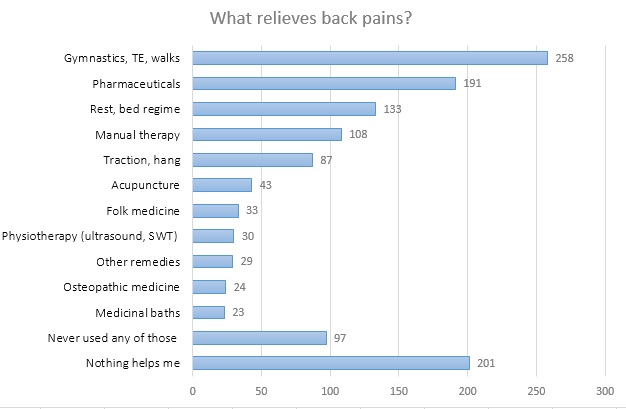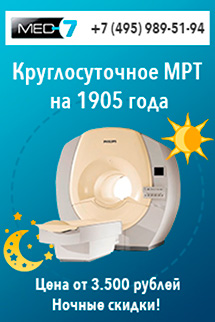What relieves back pains
What relieves back pains: poll results

Most of the world’s adult population suffers from back pain. The recent statistical investigations results have shown that 80% of the people can complain of occasional or chronic pains, and 89% of the global citizens have had at least one long period during their life when they had to fight a backache [1]. Only a small per cent of lucky ones can avoid getting to know lumbago or other unpleasant sensations in the spine region. How can a back pain be relieved? Considering the scale of the problem, this is one of the most urgent questions of the health care service. Doctors recommend taking medicines and treating our backs with gymnastics and walking. Our web site has undertaken our own study of the efficiency of different ways to relieve back pains.
The poll included 1 156 persons. The definite leaders among various methods of pain control have turned out to be gymnastics, TE, and walks. They help 20% of the respondents, that is, 235 persons of those asked. 186 respondents (16%) have confessed that nothing helps them when they have a backache, and the second effective method of pain syndrome relieving after TE and walks has turned out to be pharmaceuticals – they help 15% of those asked (170 respondents). Another 11% of the people who suffer from back pains, prefer bed regime during attacks, staying motionless. Manual therapy and traction have proven less effective for fighting pain, as only 9% and 7% of those asked are used to relying on them, while 5% of the respondents have confessed that they don’t use any of the aforesaid remedies when they have back pains. As for acupuncture, physiotherapy, osteopathic medicine, folk medicine and other methods, there are 2-3% of the respondents who are ready to resort to one of these remedies in a critical situation.
The poll results confirm that there is no heal-all remedy against pain. But why have gymnastics and walks turned out to be more effective than pain-killing medicines developed by pharmacists? The answer to this question is simple: gymnastics doesn’t act on the pain itself but on its causes. The effectiveness of this or that remedy doesn’t depend so much on its pain-relieving effect as on its ability to eliminate the very source of the problems.
When is gymnastics the best pain-killer?
If we compare the results of several polls held by our site, we can see that gymnastics, TE and walks are most often used by those people who have osteochondrosis (discal hernia) and scoliosis. All these disorders are characterized with shortened distance between the discs and metabolic disturbances. Compression syndrome can be observed in all the cases, this is pinching of the spinal nerves, which causes pain, and it’s not always located in the spine region. The compression syndrome doesn’t develop instantly, it will be preceded with a long period of degenerative changes. This is particularly typical for osteochondrosis, which causes cartilaginous tissue to destroy gradually, and also for hernia, which is a consequence of chronic osteochondrosis.
About 28% of those people who treat back pains with physical activity, lead a sedentary life, and over 50% of them lead a sedentary life with physical loads from time to time (morning exercises or walks). There is a direct relationship between the lifestyle and development of spinal disorders. Our body isn’t meant for sitting at the table or lying on the couch all the time. Staying in the same position, which isn’t also the most convenient one, for a long time, creates a static load on the spinal muscles. Only a few people can maintain the right body posture during the entire day. Most people slouch when sitting at the computer desk or dinner table, cross their legs, or choose other positions, which are no less harmful for the spine. As the result of the increased static load, the spinal muscles are overstrained and get numb, the blood runs off, and the cells cease to receive sufficient nutrition. As it is the muscles that hold the spinal discs in the correct position, when they get tired and don’t receive the necessary amount of nutrients, the position of the discs changes. Cartilaginous tissue suffers from lack of nutrients and general metabolic disturbances too. Changes in the cartilaginous tissue result in decreased distance between the discs. The spinal discs touch the roots of spinal nerves, and a sharp or gnawing pain occurs.
Independent researches confirm that there is a relation between the habituation to static positions and spinal disorders. More than 34% of our readers have noticed a clear connection between sitting still for a long time, staying in the same position, and occurrence of pain in the spinal region. Another 39% complain of chronic pains. Lack of motion activity makes the entire spine suffer, but it’s worst of all for the low back and neck regions. It’s the low back that takes the most load when you sit in the same position for a long time.
If the back pain goes away after walking, TE or gymnastics, this means that your problems with the spine result from your lifestyle. Motion activity stimulates the metabolism, gymnastics and TE normalize the distance between the spinal discs, blood flushes to the tissues, carrying nutrients with it. Besides, motion has a generally invigorating effect, making the cardiovascular, respiratory and immune systems function more intensively. To get rid of backaches forever, you would have to change your lifestyle, giving up your passive rest on the sofa for going in for sports and spending time in the open air. Irrespective of your age, exercises for stretching of the spine would be useful. Even the most simple stretch increases the distance between the discs, eliminating the cause of the pain and stopping the compression syndrome from developing.
When you go in for sports, you should observe the “safety rules”, try not to overstrain the muscles. Doing gymnastics without previous warming-up exercises can lead to microtraumas of spinal muscles, which cause acute pain. And if you have tissue microruptures, TE and walks will not help in this case – you will need rest and pain-relieving medications.
Bed regime and pharmaceutical drugs
Sometimes bed regime and complete rest are they only way of fighting pain syndrome. Bed rest and taking medications are required when one has an acute pain caused by microtraumas of muscles, inflammation and compression of spinal nerves. The pain may result from excessive load on the back. The irony is that there is a stable relation between lumbago occurring after overstrain, and the sedentary life. Unexercised muscles, weakened after constant sitting, are simply unable to sustain the load. One may “tear” their back after carrying a couple of heavy bags from the shop or moving an armchair. At the same time, sportsmen can lift much heavier weights without any risk to harm their spine because the well-developed spinal muscles can sustain the strain with no problems.
If rest and medications are the only things that can save you from pain, it means that there is a muscle spasm or tissue inflammation in some section of the spine. When we deal with spasms and inflammatory processes, doing exercises is not only useless but even harmful. Gymnastics and TE must become your “best friends”, but only after the acute stage of the disorder is over. They you can begin strengthening your muscles and returning normal flexibility to your spine.
When an acute pain goes away, many people take it for recovery – and return to their habitual lifestyle. This is a mistake. If the pain syndrome disappears, this doesn’t mean yet that you are completely healthy. If you have to stay in bed from time to time or to take pain killers, it means that you need a doctor’s examination and thorough diagnostics, including magnetic resonance tomography. Bed rest and medicines as such don’t affect the source of the problems, they fight the symptoms. Only after the cause of the pain has been found and eliminated, you can say that you have recovered and do not need medical care any longer. What drugs can be prescribed for acute back pains?
- Anti-inflammatory non-steroidal drugs are meant for removal of inflammation. They have to be taken for quite a long time, therefore doctors aim to prescribe such medicines in such dosages, which don’t cause side effects to occur. Unfortunately most anti-inflammatory non-steroidal drugs have unpleasant side effects, for example, they can affect liver function. So one must not disobey the schedule of medication intake and its dosage, which has been indicated in the instruction or prescribed by the doctor.
- Analgetic drugs can remove pain syndrome quite promptly, but they don’t affect its cause in any way. Remember: if the pain has gone, this doesn’t mean that the course of treatment has been finished. Sometimes the doctor administers injections of analgetic drugs all around the affected area of the back to relieve acute pain, as injections help to relieve a severe pain for a long time.
- Muscle relaxants are meant for removal of muscle spasms. Excessive load or hypothermia cause spasm, the spasm causes pain – and the pain continues provoking spasmodic symptoms. An attempt to massage the stiff back in such a situation will only make things worse. It is a vicious circle, which can be broken only with the help of medications. Drugs of the muscle relaxants group can solve this problem effectively.
Manualtherapyandtraction
Manual therapy and traction act according to the same principle as gymnastics, with the only difference that gymnastics supposes the patient’s activity, and when spine traction is done, the patient remains passive. This is why these methods are less effective than TE, gymnastics and walks. They try to act on the cause of pain, increasing the distance between discs and stimulating blood circulation, but there is only one way for strengthening the spinal muscles, and it is moderate physical activity. Without general normalization of the metabolism and some training of the muscles the treatment would have only a short-term effect. For example, traction returns the normal distance between the discs, but the spinal bones take up wrong position quickly. Besides, manual therapy and traction still remain leaders by the number of aggravations. Only an experienced doctor can cope with such treatment, who knows his business through and through. Also the specialist must know the objective anamnesis, so that he can calculate the load correctly. Excessive load during traction, or wrong choice of manipulations during manual therapy can cause pain to become more severe. If you are used to resorting to the help of a chiropractic, you’d better look for a good TE instructor. If you do gymnastics, you’ll be able to avoid periodic visits to the doctor.
Понравилась статья? Поделись с друзьями!
Также стоит почитать:
Загрузка...



































 Важно знать:
Важно знать: Полезно:
Полезно: Интересно:
Интересно:




